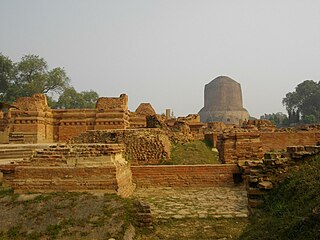
Sarnath is a place located 10 kilometres northeast of Varanasi, near the confluence of the Ganges and the Varuna rivers in Uttar Pradesh, India.

Shikharji, also known as Sammet or Sammed Shikharji, is one of the holiest pilgrimage sites for Jains, in Giridih district, Jharkhand. It is located on Parasnath hill, the highest mountain in the state of Jharkhand. It is the most important Jain Tirtha, for it is the place where twenty of the twenty-four Jain tirthankaras along with many other monks attained Moksha. It is one of the five principal pilgrimage destinations along with Girnar, Pawapuri, Champapuri, Dilwara, Palitana and Ashtapad Kailash.

Parshvanatha, or Pārśva and Pārasanātha, was the 23rd of 24 Tirthankaras of Jainism. Parshvanatha is one of the earliest Tirthankara who is acknowledged as a historical figure. The Jain sources place him between the 9th and 8th centuries BCE whereas historians consider that he lived in the 8th and 7th century BCE.

In Jainism, a tīrtha is used to refer both to pilgrimage sites as well as to the four sections of the sangha. A tirtha provides the inspiration to enable one to cross over from worldly engagement to the side of moksha.

Sri Digambar Jain Lal Mandir is the oldest and best-known Jain temple in Delhi, India. It is directly across from the Red Fort in the historical Chandni Chowk area.

Dhamek Stupa is a massive stupa located at the archaeological site of Sarnath in the state of Uttar Pradesh, India. Dhamek Stupa marks the location where the Buddha preached his first discourse to his first five disciples, and where all five eventually became fully liberated.
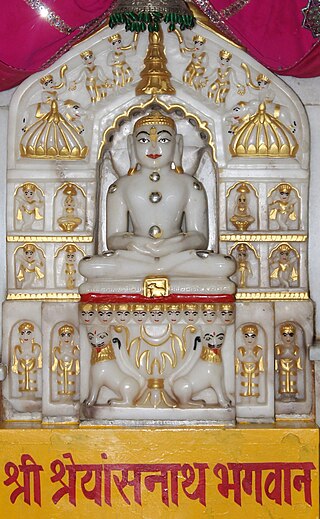
Shreyansanath was the eleventh Jain Tirthankara of the present age (Avasarpini). According to Jain beliefs, he became a Siddha – a liberated soul which has destroyed all of its karma. Shreyansanatha was born to King Vishnu and Queen Vishna at Simhapuri, near Sarnath in the Ikshvaku dynasty. His birth date was the twelfth day of the Falgun Krishna month of the Indian calendar.

Śāntinātha or Śānti is the sixteenth Tīrthaṅkara of Jainism in the present age. According to traditional accounts, he was born to King Vishvasena and Queen Aćira of the Ikshvaku dynasty in the north Indian city of Hastinapur. His birth date is the thirteenth day of the Jyest Krishna month of the Indian calendar. He was also a Chakravarti and a Kamadeva. He ascended to the throne when he was 25 years old. After over 25,000 years on the throne, he became a Jain monk and started his penance.
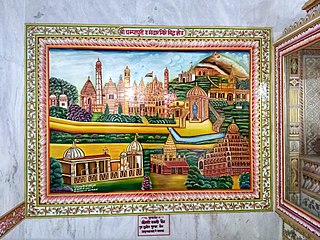
Champapuri, Champa Nagri or Champanagar is a neighbourhood in Bhagalpur in the Indian state of Bihar. It is the site of the ancient city of Champa, the capital of the Anga Mahajanapada. It is also the main centre of capital of cultural region of Anga.
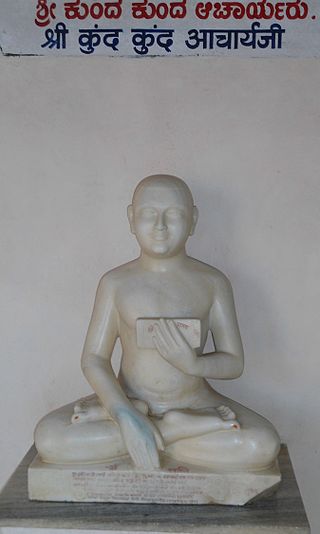
Digambara is one of the two major schools of Jainism, the other being Śvetāmbara (white-clad). The Sanskrit word Digambara means "sky-clad", referring to their traditional monastic practice of neither possessing nor wearing any clothes.

Uttar Pradesh, a state in north India has a long association with Jainism. Today the state is home to a number of Jain monuments, such as Jain Temples and Jain Tirths. There are around 213,267 Jains in Uttar Pradesh according to the 2011 Census of India.

Jainism is an Indian religion which is traditionally believed to be propagated by twenty-four spiritual teachers known as tirthankara. Broadly, Jainism is divided into two major schools of thought, Digambara and Śvetāmbara. These are further divided into different sub-sects and traditions. While there are differences in practices, the core philosophy and main principles of each sect is the same.
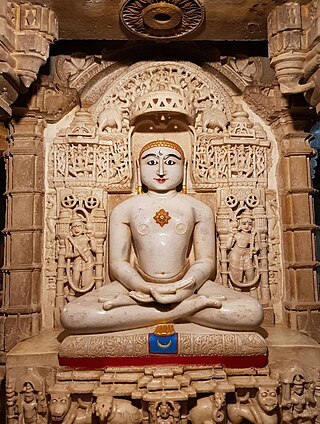
Chandraprabha or Chandranatha is the eighth Tirthankara of Tīrthaṅkara of Jainism in the present age. According to traditional accounts, he was born to King Mahasena and Queen Lakshmana Devi at Chandrapuri to the Ikshvaku dynasty. According to Jain texts, his birth-date was the twelfth day of the Posh Krishna month of the Indian calendar. He is said to have become a siddha, a liberated soul which has destroyed all of its karma.

Kundalpur is a village in Nalanda district in the Indian state of Bihar. It is located about 2.5 kilometres from ancient Nalanda Mahavihara, 11 kilometres southwest of Bihar Sharif, and 80 kilometres southeast of Patna.
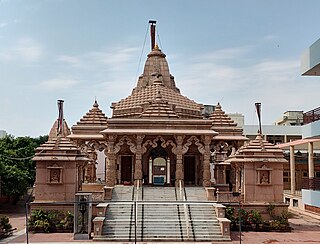
Parshvanath Jain temples, Varanasi is a group of three Jain temples located in Bhelupur, Uttar Pradesh. The temples in Bhelupur were built to commemorate place for three kalyanaka of Parshvanatha.

Ancient idols of Jain Tirthankara were found in archaeological expeditions in Badli, Bhiwani, Dadri, Gurgaon, Hansi, Hisar (Agroha), Kasan, Nahad, Narnaul, Pehowa, Rewari, Rohad, Rohtak and Sonepat in Haryana. Agrawal Jain community traces its origins from Hisar. Guptisagar Dham Tirtha at Ganaur is a religious tourist spot in Haryana. It is named after the Jain Acharya Guptisagar.

Jain temple, Kundalpur is a complex of six Jain temples located in Kundalpur village near Nalanda, Bihar. Kundalpur is one of the most important Jain pilgrimages in Bihar.

Jain temples, Pavagadh is a group of seven Jain temples located in Pavagadh Hill in the state of Gujarat. These temples are part of the UNESCO World Heritage Site of Champaner-Pavagadh Archaeological Park.
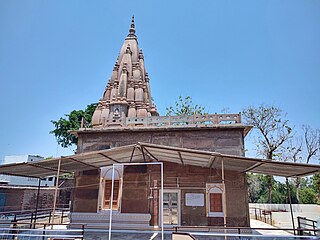
Chandrawati Jain temple is a Jain tirth located in the Chandrawati village located 23 kilometres (14 mi) from Varanasi. This place is believed to be birthplace of Chandraprabha, the 8th Thirthankara, of Jainism.






















